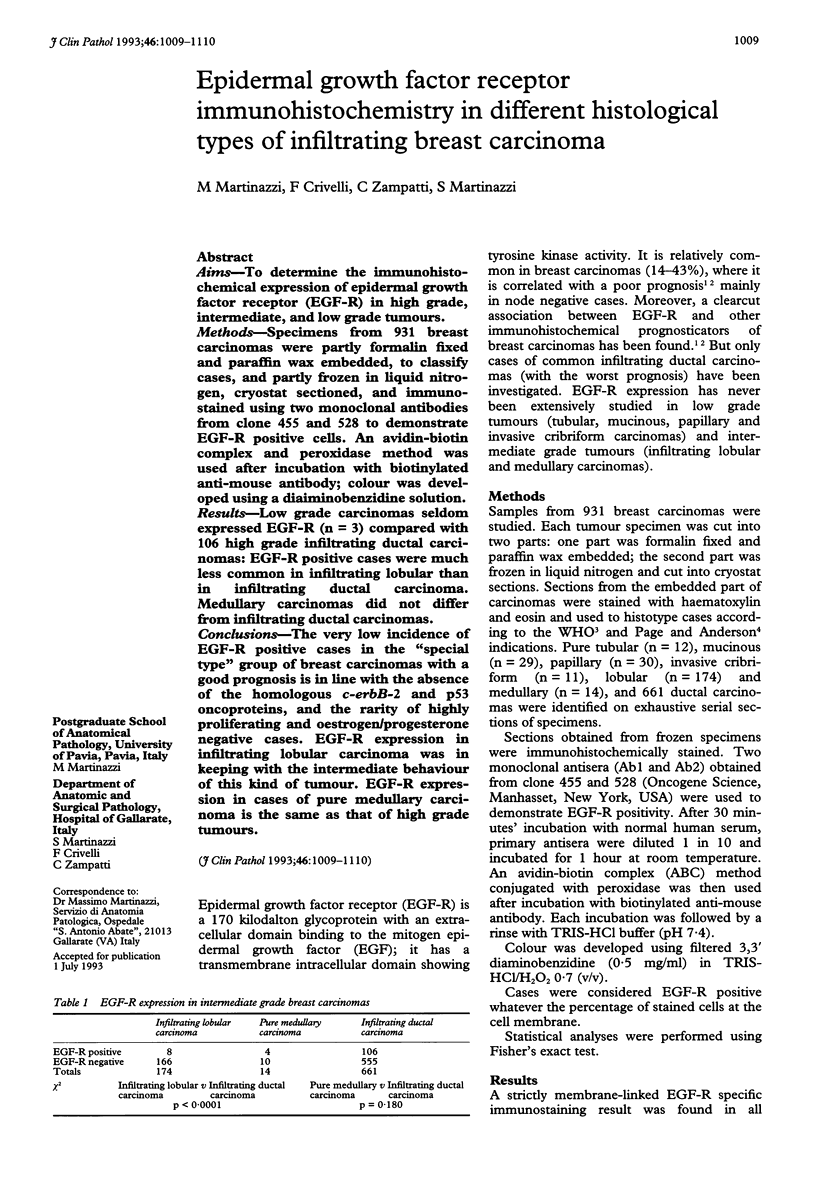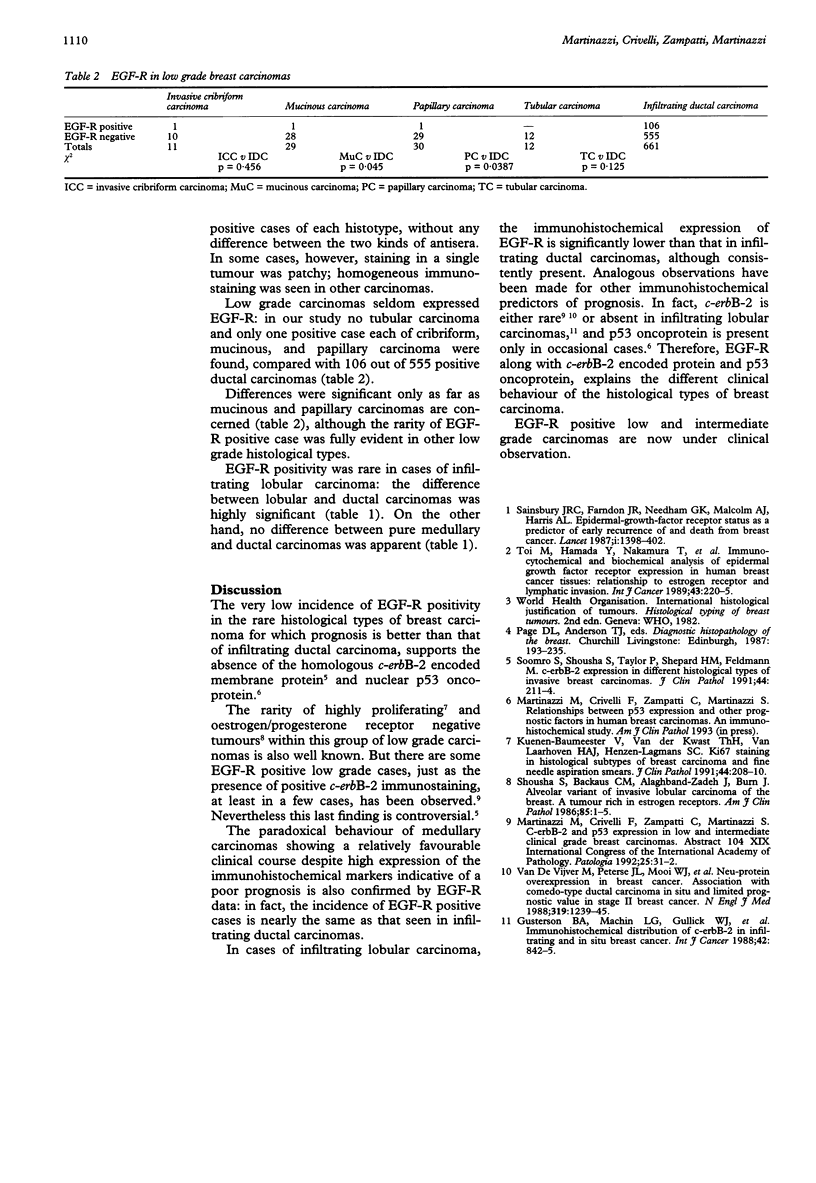Abstract
AIMS--To determine the immunohistochemical expression of epidermal growth factor receptor (EGF-R) in high grade, intermediate, and low grade tumours. METHODS--Specimens from 931 breast carcinomas were partly formalin fixed and paraffin wax embedded, to classify cases, and partly frozen in liquid nitrogen, cryostat sectioned, and immunostained using two monoclonal antibodies from clone 455 and 528 to demonstrate EGF-R positive cells. An avidin-biotin complex and peroxidase method was used after incubation with biotinylated anti-mouse antibody; colour was developed using a diaiminobenzidine solution. RESULTS--Low grade carcinomas seldom expressed EGF-R (n = 3) compared with 106 high grade infiltrating ductal carcinomas: EGF-R positive cases were much less common in infiltrating lobular than in infiltrating ductal carcinoma. Medullary carcinomas did not differ from infiltrating ductal carcinomas. CONCLUSIONS--The very low incidence of EGF-R positive cases in the "special type" group of breast carcinomas with a good prognosis is in line with the absence of the homologous c-erbB-2 and p53 oncoproteins, and the rarity of highly proliferating and oestrogen/progesterone negative cases. EGF-R expression in infiltrating lobular carcinoma was in keeping with the intermediate behaviour of this kind of tumour. EGF-R expression in cases of pure medullary carcinoma is the same as that of high grade tumours.
Full text
PDF

Selected References
These references are in PubMed. This may not be the complete list of references from this article.
- Gusterson B. A., Machin L. G., Gullick W. J., Gibbs N. M., Powles T. J., Price P., McKinna A., Harrison S. Immunohistochemical distribution of c-erbB-2 in infiltrating and in situ breast cancer. Int J Cancer. 1988 Dec 15;42(6):842–845. doi: 10.1002/ijc.2910420608. [DOI] [PubMed] [Google Scholar]
- Kuenen-Boumeester V., Van Der Kwast T. H., Van Laarhoven H. A., Henzen-Logmans S. C. Ki-67 staining in histological subtypes of breast carcinoma and fine needle aspiration smears. J Clin Pathol. 1991 Mar;44(3):208–210. doi: 10.1136/jcp.44.3.208. [DOI] [PMC free article] [PubMed] [Google Scholar]
- Sainsbury J. R., Farndon J. R., Needham G. K., Malcolm A. J., Harris A. L. Epidermal-growth-factor receptor status as predictor of early recurrence of and death from breast cancer. Lancet. 1987 Jun 20;1(8547):1398–1402. doi: 10.1016/s0140-6736(87)90593-9. [DOI] [PubMed] [Google Scholar]
- Shousha S., Backhous C. M., Alaghband-Zadeh J., Burn I. Alveolar variant of invasive lobular carcinoma of the breast. A tumor rich in estrogen receptors. Am J Clin Pathol. 1986 Jan;85(1):1–5. doi: 10.1093/ajcp/85.1.1. [DOI] [PubMed] [Google Scholar]
- Soomro S., Shousha S., Taylor P., Shepard H. M., Feldmann M. c-erbB-2 expression in different histological types of invasive breast carcinoma. J Clin Pathol. 1991 Mar;44(3):211–214. doi: 10.1136/jcp.44.3.211. [DOI] [PMC free article] [PubMed] [Google Scholar]
- Toi M., Hamada Y., Nakamura T., Mukaida H., Suehiro S., Wada T., Toge T., Niimoto M., Hattori T. Immunocytochemical and biochemical analysis of epidermal growth factor receptor expression in human breast cancer tissues: relationship to estrogen receptor and lymphatic invasion. Int J Cancer. 1989 Feb 15;43(2):220–225. doi: 10.1002/ijc.2910430208. [DOI] [PubMed] [Google Scholar]
- van de Vijver M. J., Peterse J. L., Mooi W. J., Wisman P., Lomans J., Dalesio O., Nusse R. Neu-protein overexpression in breast cancer. Association with comedo-type ductal carcinoma in situ and limited prognostic value in stage II breast cancer. N Engl J Med. 1988 Nov 10;319(19):1239–1245. doi: 10.1056/NEJM198811103191902. [DOI] [PubMed] [Google Scholar]


